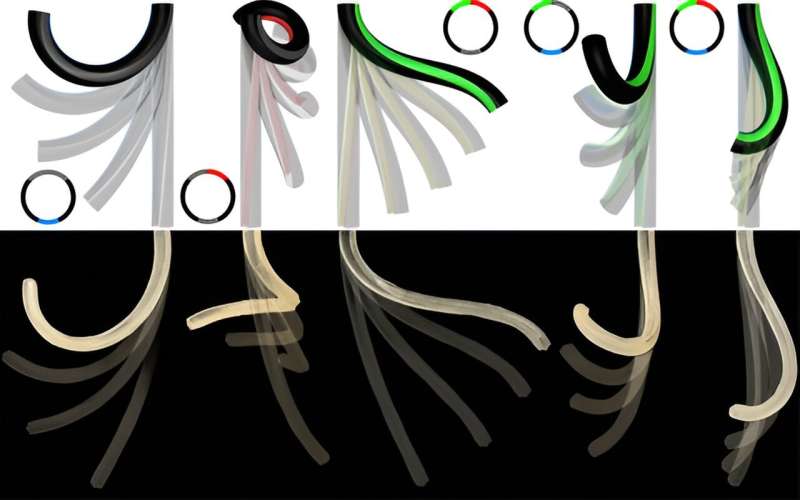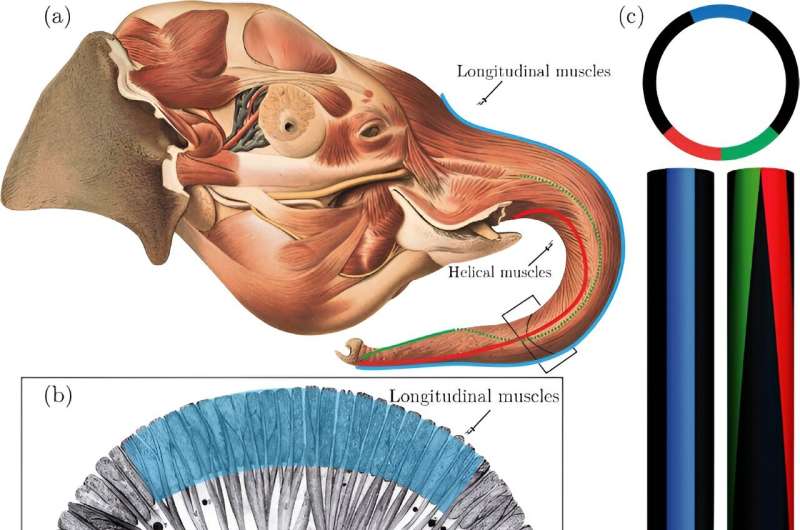July 24, 2024 feature
This article has been reviewed according to Science X's editorial process and policies. Editors have highlighted the following attributes while ensuring the content's credibility:
fact-checked
peer-reviewed publication
trusted source
proofread
Study shows elephant trunk dexterity can be mimicked with minimal actuators

The trunk of an elephant is among the versatile appendages in the animal kingdom. Now a research team has shown that most of its dexterity can be reproduced with a model using just three "muscles." And they built a physical model to do just that. The findings are published in the journal Physical Review Letters.
An elephant's trunk is composed of 17 muscles—eight on each side plus one for its nasal cavity—controlled by tens of thousands of muscle fibers commanded by up to 60,000 facial neurons. With this, they breathe, smell, trumpet, grab food, suck up water, spray themselves with water, mud or dust, groom other elephants, and occasionally use it as a weapon. It does this via certain muscle movements, such as contraction, changes in torsion (twisting by an applied force or torque) and stretching.
"We were fascinated by the elephant trunk both for its majesty but also intrinsic physics," said Alain Goriely, a member of the research team, from the Mathematical Institute at the University of Oxford in the UK.
"It seemed to us a paradigm for control of filamentary shape in a three-dimensional environment," which would be especially useful for designing certain types of robots. Goriely noted that the same type of physics is used in climbing plants through differential tissue growth and the arms of octopuses.
The research group, composed of engineers from Stanford University in California and mathematicians from the University of Oxford in the UK, sought to design a trunk-like arm that mimicked an elephant's trunk using a minimum of actuators. (An actuator is a device that produces a force or displacement in response to an input, such as an electrical current.)
They first constructed a mathematical model of a trunk as a slender biological filament that changes through activation of longitudinal, radial, and helical "muscles," including the force of gravity.

"To explore a three-dimensional world with a curve attached at a point, you need to create both curvature and torsion," said Goriely.
Inspired by the muscular structure of an elephant's trunk, the team combined a longitudinal actuator along the length of their model trunk, similar to a major muscle group located atop the elephant trunk. They added helical actuators, one right-handed and one left-handed, again similar to an actual elephant.
Their mathematics showed that such a single muscular bundle with two opposing helical bundles could generate a variety of trunk deformation modes, both in- and out-of-the-plane of the curled-up trunk. They combined those modes to create a minimal design of a flexible tubular structure: one longitudinal and two helical "fibers."
To put their mathematical model into physical form, they made a soft, slender, polymer-based cylindrical structure. For the actuators, they used 3D printing to form liquid-crystalline elastomer fibers that contract in a single direction when heated. Each fiber had a copper wire embedded within it; warming them electrically caused the fibers to contract in one direction via Joule heating.
In this way, each "muscular" actuator could be controlled independently. Pure bending of the trunk structure could be created by contracting a single actuator along its length, torsion was exhibited through activation of the helical actuators, and a combination of bending and torsion with all three actuators generated motion out of the plane.
"Once properly calibrated, we could reproduce all the basic modes predicted theoretically and also found in the elephant trunk," Goriely said.
To evaluate their result, the team calculated the model trunk's "reachability" cloud—the three-dimensional space into which the trunk can move. The cloud spanned the entire 360° arc around the longitudinal trunk, meaning "our minimal trunk design can reach points to the front, back, right, and left of the initial configuration, as well as anywhere in between these regions," their paper says.
Compared to other (mathematical) designs containing three longitudinal actuators or two helical actuators "our minimal design is vastly superior in terms of reachability." For instance, the volume of the reachability cloud decreased by 14% when the two helical actuators were replaced with longitudinal ones. Removing the single longitudinal actuator in the minimally designed trunk limited its reachability cloud to a two-dimensional surface.
As well, the torsion available with three actuators, one longitudinal and two helical, enabled the trunk to "not only reach a larger space, but also perform a variety of complex motions, including avoiding obstacles or grasping and rotating objects through curling, a common motion performed by elephant trunks when manipulating branches of trees."
This minimal design trunk does have a few limitations: it cannot be elongated or shortened, and further study is needed on the efficiency with which it can handle loads of different sizes and weights. But compared to traditional robot arms, the large reachability cloud of this minimal design suggests its use of robotics such as motion planning tools, which are often robots with arms and joints used on production lines.
More information: Bartosz Kaczmarski et al, Minimal Design of the Elephant Trunk as an Active Filament, Physical Review Letters (2024). DOI: 10.1103/PhysRevLett.132.248402
Journal information: Physical Review Letters
© 2024 Science X Network





















